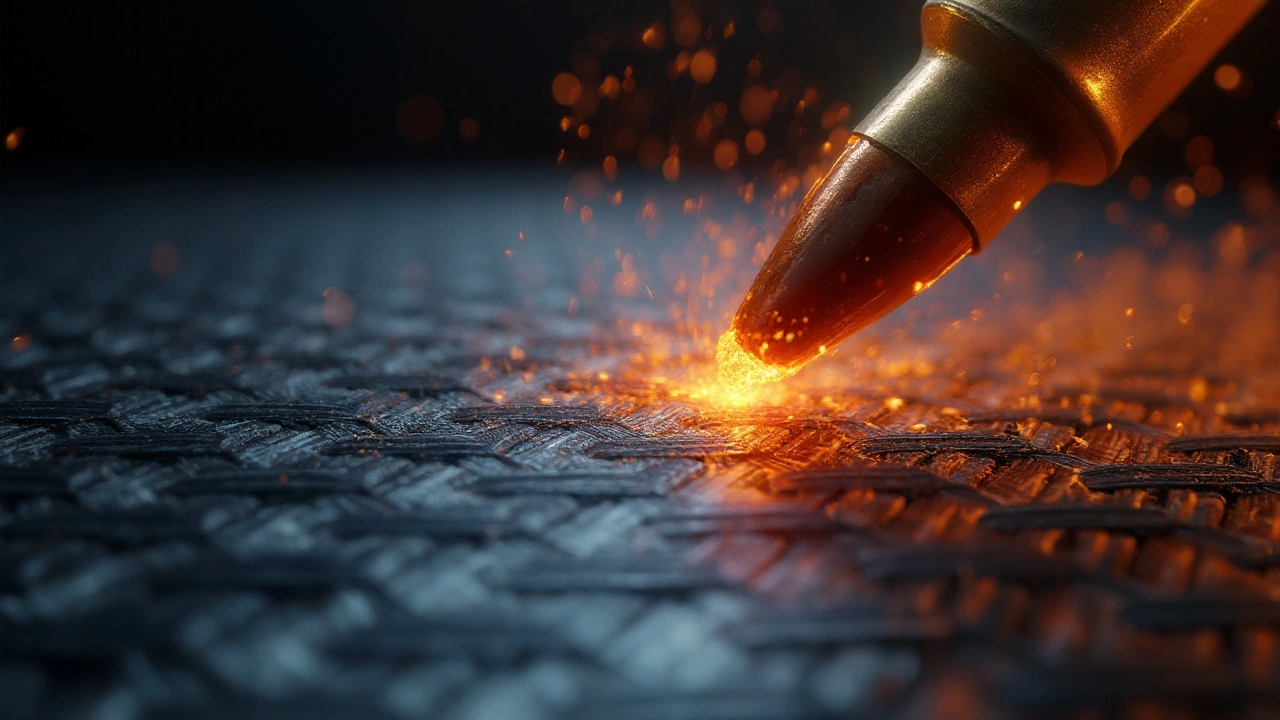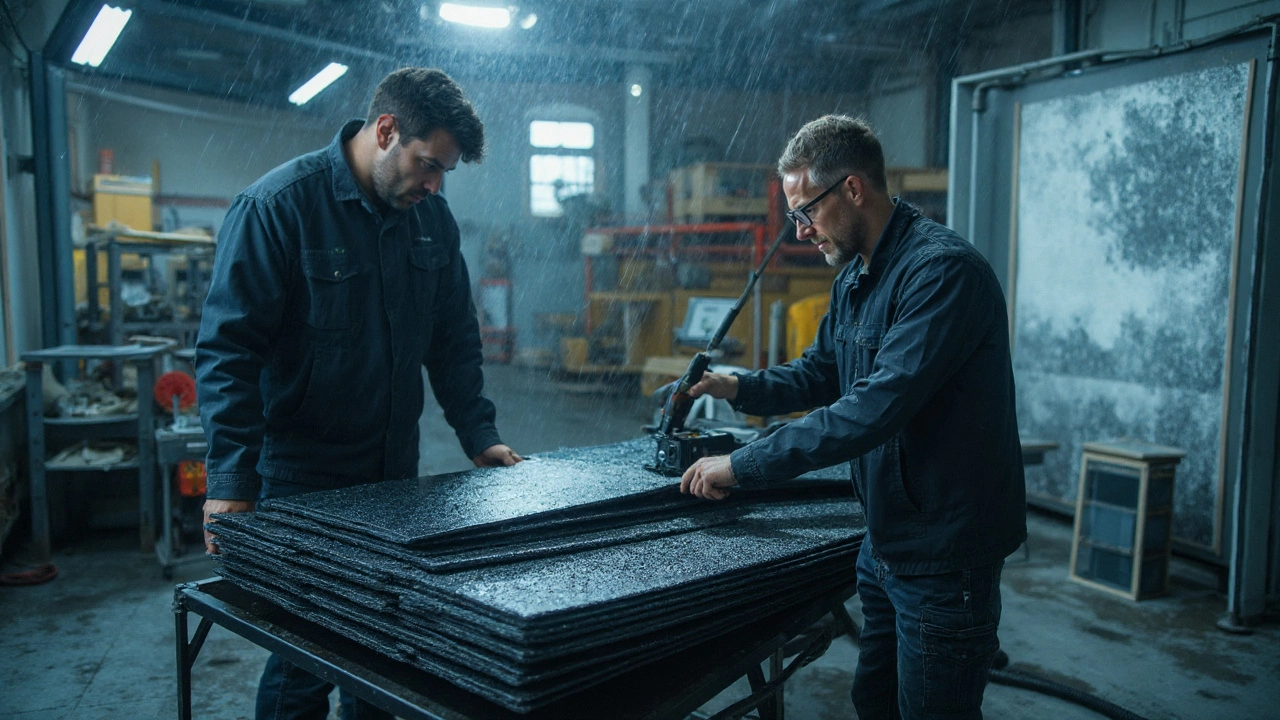If you put a slab of carbon fiber on the table and ask, “Could this stop a bullet?”, you’re bound to get some raised eyebrows. Carbon fiber looks tough. It feels high-tech. You hear about it making cars lighter and bikes stronger. Military gear, race cars, jet fighters — it’s everywhere serious performance is needed. But the truth about its resistance to gunfire? It’s more complicated than you’d think, and the answer twists through engineering, materials science, and a few myths you might have seen on TV.
What Carbon Fiber Is — And Why It Feels So Tough
There’s a reason you see carbon fiber bragged about on luxury cars, aircraft, and even in sporting goods — its weight-to-strength ratio is nuts. In simple terms, you get more strength for less weight than with just about any metal. Carbon fiber isn’t a metal, though. It’s made from super thin filaments of carbon, usually spun together like yarn, then locked in place by resins to form a rigid “composite.” When you touch a carbon fiber panel, you’re feeling those perfectly lined-up fibers trapped inside a hardened plastic.
When people say carbon fiber is “five times as strong as steel,” they aren’t lying — but it’s only true in a very straight pull (think of yanking on a rope). In that kind of load, known as tensile strength, carbon fiber blows most metals away. But real bullets don’t pull gently. They punch, jab, and shatter things with furious energy delivered in a fraction of a second. That brings a whole different kind of stress called impact resistance, and here carbon fiber’s superpowers don’t always translate. Let’s break this down with some specifics:
| Material | Tensile Strength (MPa) | Density (g/cm³) | Relative Stiffness |
|---|---|---|---|
| Carbon Fiber Composite | ~4000 | ~1.6 | Very High |
| Steel | ~1200 | ~7.8 | High |
| Kevlar (Aramid Fiber) | ~3620 | 1.44 | Medium |
| Aluminum Alloy | ~570 | 2.7 | Medium |
Notice the numbers for tensile strength and density; carbon fiber wins on strength-to-weight by a mile, but that doesn’t tell the bullet story yet.

How Carbon Fiber Handles Bullets, Impacts, and Real-World Damage
When a bullet smashes into something, it delivers a ridiculous amount of kinetic energy in a tiny spot. The real test is: can the material absorb and spread that blow fast enough so nothing ruptures? With carbon fiber, the answer isn’t straightforward. Carbon fiber panels are great at spreading out loads — think of an F1 crash, and you’ll see the car spray parts everywhere, the chassis often left mostly untouched. But when it comes to “penetration”, things get dicey. Carbon fiber tends to shatter, delaminate (layers split apart), or even let the bullet punch through at high speeds.
There are videos online of people shooting at carbon fiber sheets. What usually happens? If the carbon fiber is thick enough or backed by another material (like plastic, foam, or even metal), the first round might stop. But shoot a few more, or use a more powerful round, and the carbon fiber breaks apart like a shattered plate. Unlike bulletproof materials such as Kevlar, which stretch and “catch” the bullet, carbon fiber is rigid. Once it cracks, it’s pretty much done.
Let’s break down a few actual outcomes when carbon fiber is hit with gunfire:
- Low-caliber rounds (like .22 pistol): Might be stopped if the carbon fiber is thick and made with fancy resin, but more likely it’ll leave a dent or fracture.
- High-caliber rounds (9mm, .45, rifles): Almost never stopped by carbon fiber alone. Rounds go through or tear big chunks out.
- Protected composites: Panels mixing carbon fiber with Kevlar or metal can stop bullets, but it’s usually the other material doing the heavy lifting.
- Multiple hits: Carbon fiber gets weaker with every shot. Once it chips, cracks spread, ruining its stopping power.
Here’s the wild part: Carbon fiber’s job isn’t usually to stop bullets on its own. Car and aircraft designers use it because it’s light, stiff, and dampens vibration. If you need to actually stop bullets, you’re better off with materials with high energy absorption — Kevlar or special ceramics.
Some bulletproof vests even combine carbon fiber with other stuff to add stiffness, but it’s always paired because on its own, carbon’s “brittle.” It doesn’t dent — it snaps. Not what you want if your chest is behind it. Still, in the rare case of the bullet’s energy spread out by a thick, layered carbon fiber composite (think a thick shield, not a car hood), it might slow the bullet down — but usually not enough to call it “bulletproof”.

Where Carbon Fiber Really Wins: Tips, Myths, and Practical Uses
So why do you hear about carbon fiber in “armored” cars, or why do people believe it’s bulletproof? Simple: misunderstanding what engineers mean by strength. A car’s carbon fiber roof will keep you safer in a rollover, but it won’t save you in a drive-by. The myth usually starts with racing — when high-speed crashes look shockingly survivable thanks to durable monocoques. But those impacts are spread over much larger areas and timeframes, and bullets don’t work like that.
Bearing that in mind, here’s where carbon fiber shines and where it shouldn’t be trusted:
- Perfect use-cases: Supercar panels, bike frames, aircraft wings. You get ultra-low weight and massive stiffness.
- Protective gear: Good for skate helmets or hockey sticks where blunt force, not sharp piercing, is the risk.
- Disaster situations: Wind, hail, even most small debris — carbon fiber shrugs it off. Add steel or Kevlar for armor, but that boosts weight.
- Not for: Simple bullet stopping. If you want actual bullet protection, you have to look at layered solutions — usually carbon fiber for the outside skin (rigidity), then aramid fibers or ceramics (energy absorption and stopping power).
Curious about how this shows up in cars? Only the most expensive armored sedans (think VIP limos) will even include carbon fiber, and mostly as a way to support the real protective stuff beneath (Kevlar, ultra-hardened steel, ceramics). Even then, it adds cost and is tricky to repair. Repair shops here in Melbourne aren’t set up to fix cracked carbon fiber in bulletproof glass or doors — it’s specialist work, and wildly expensive.
Here’s a myth buster: back in the 2010s, some supercar brands dabbled with “carbon fiber armor,” mostly for marketing flair. The real bullet-stopping layers were always something else, with the carbon fiber just there for looks or structure, never as the actual barrier. Even police shields, when using carbon fiber, sandwich it between other materials for rigidity, not for stopping a bullet.
If you’re ever caught in a wild situation and only have your carbon fiber-skinned car between you and a bullet — duck. It won’t help much more than a metal panel. But if you want a car that’s light, precise in steering, and feels like a spaceship, that’s where carbon fiber is king. Just remember to keep your ideas about its bullet-stopping powers in check — it’s meant for a different kind of heroics.




